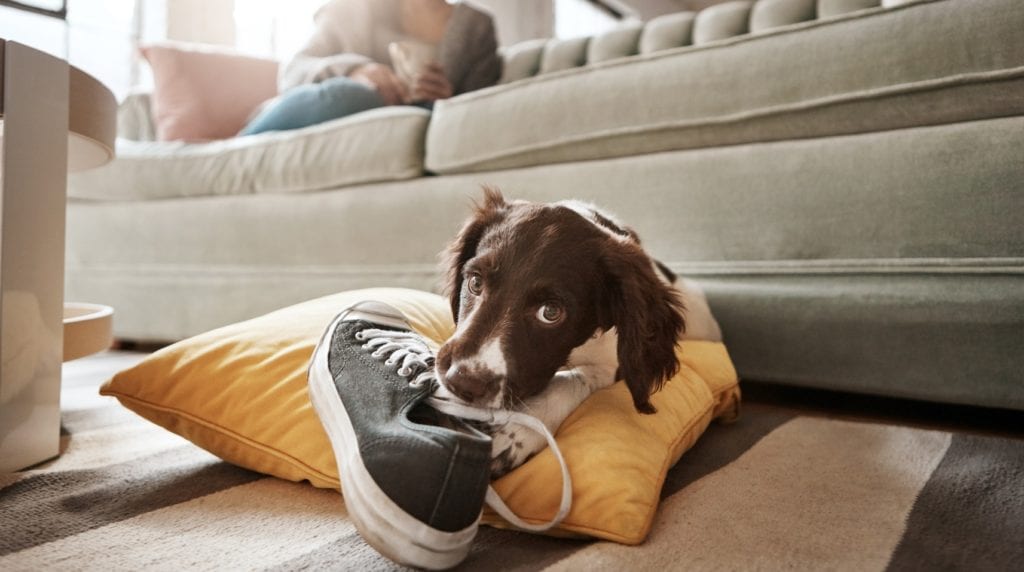
Photo: GettyImages/gradyreese
The number of American households that has at least one pet now stands at more than 85 million — that’s 68 percent of all U.S. households (up from 56 percent in 1988), according to the 2017-2018 National Pet Owners Survey.
It’s no exaggeration to say that Americans love their pets and treat them as members of the family, so it stands to reason that they’d consider many ways to accommodate pets when building a new home. For example, it’s becoming more common to find pet washing stations and pet rooms in newly built homes these days.
When building your dream home, there are some considerations to make when it comes to your pet to ensure they are as safe as can be. Here are some ideas to pet-proof your new home for their safety:
It’s All in the Flooring
Many pet owners may opt for soft carpet in their homes. If you choose carpet, make sure it won’t be difficult for your pet to walk on it. “Choose a cut-loop carpet, as a pet’s nails can get caught, which can cause torn nails and great pain,” says DeAnna Radaj, a Charlotte, N.C.-based designer.
Veterinarian Kerri Marshall, chief veterinary officer for pet insurance company, Trupanion, agrees. She explains that pets can ingest shag carpet or carpet tack. “Select hardwood, tile or low-pile carpeting for each room that the pet may frequent,” Marshall says.
While many pet owners choose hardwood flooring or tile for easier maintenance, it’s important to make sure your pet can handle such hard surfaces. Older dogs, for example, may find it difficult to land on hard surfaces when jumping down from a bed or sofa. If this is the case, perhaps a runner or pet steps can help.
Indoor Air Quality Is Important to Pets TooI
When you choose building products that emit fewer toxins, like low-VOC (volatile organic compounds) paint, you are making a healthier choice for your family – both two-legged and four-legged. Marshall says that Trupanion receives twice as many respiratory-related claims from pets in polluted regions than the national average, so indoor air quality is just as important for pets as for you.
“Just like with humans, outdoor and indoor contaminants can affect pet health, including allergens, mold, dust, second-hand smoke, aerosol sprays and paint fumes,” she says. “To keep the air in the home healthy, pet owners can utilize a HEPA air filter, use natural products when furnishing and cleaning and employ non-toxic plants to purify the air in the home.”
If you do use indoor plants to clean the air, be sure that they are not toxic to your pet.
Gates Aren’t Only For Babies
In the last 40 years, the number of American households that has at least one pet has tripled to more than 84 million. If there is an area of the home that you’d like to keep your pet away from — such as the kitchen where food, trash cans or cleaning supplies are stored — use a baby or pet gate to prevent passage. This will keep pets in a designated area where they have access to only what you want them to — their beds, food bowls and toys — and not to items such as shoes or pillows.
Gates can also be used to prevent access to stairs, which may be a hazard to pets, especially those that haven’t yet mastered steps. Because gates come in all sizes, materials and have a variety of price points, there is something for small pets, medium-sized pets, large or extra-large pets or pets that tend to jump.
Other Concerns
A sliding door may be a great way to get the indoor-outdoor lifestyle in your new home, but be sure that your pet understands when the door is closed. A pet that may not understand when a door is closed can run or fly into it at high speeds. Help them practice entering your home until they understand how the sliding or screened door works.
Speaking of outdoor spaces, if you have a deck, be sure to keep it maintained to prevent paws from getting splintered (that’ll also keep our own feet splinter-free).
As you embark on your new home journey, don’t forget to consider your furry friend. You’ll find that the more comfortable your pet is in your new home, the easier it is for you to protect your pet from any hazards. The peace of mind you’ll have knowing that your pet is safe in your new home is priceless.

Patricia L. Garcia is an award-winning freelance journalist who has written for NewHomeSource, the Associated Press, New Mexico magazine and the Texas Bar Journal. When not writing, she can be found in the garden, battling weeds and high-desert heat.

